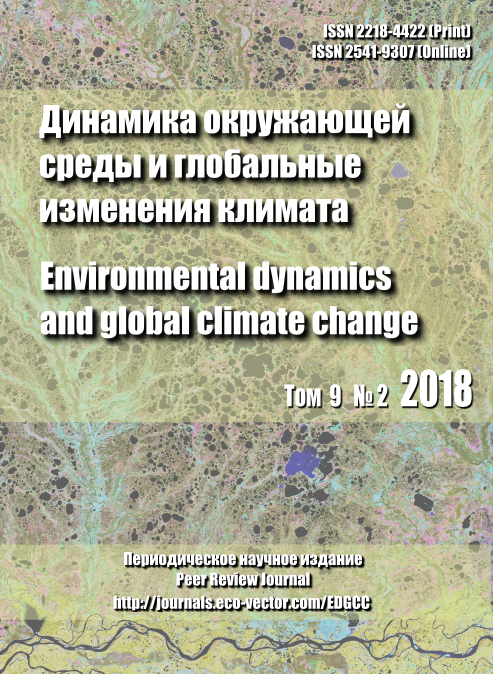Long-term phenoclimatic averages of the Yuganskiy Nature Reserve territory and changes for 1961-2016
- Authors: Zvyagina E.A.1, Pereyaslovets T.S.1
-
Affiliations:
- Yuganskiy Nature Reserve
- Issue: Vol 9, No 2 (2018)
- Pages: 28-39
- Section: Experimental works
- URL: https://bakhtiniada.ru/EDGCC/article/view/10367
- DOI: https://doi.org/10.17816/edgcc10367
- ID: 10367
Cite item
Full Text
Abstract
In light of the observed global climate changes in recent decades, we studied the local climate indicators and explored the possible links between the spring and autumn phenophases and climate data changes in the Yuganskiy nature reserve (N 600 17’; E74054’ – N590 23’; E74000’) in 1982-2016. The collected climate data include daily average, maximum and minimum temperatures, daily precipitation amount and intensity, and number of days with precipitation of 0.1mm or more, monthly average of snow depths, dates of first and last occurrence of daily mean temperatures 0, +5, +10°С through the year. Timing of sap movement and leaf fall start were used as the spring and autumn indicators of birch (Bétula péndula ) phenology. The mean value of weather averages in the 30-year period of 1961-1990 was used as reference. Trends were calculated using linear least squares regression. Statistical significance was determined by calculating the standard error of the trend estimate.
We found that the annual mean temperature has increased from –1.9°С (1961-1990) to –0.8° С (1982-2016), with corroborating indicators including increased temperature of the coldest night of the year from –53°С (1961-1990) to –51.3° С (1982-2016) and increased frequency of significant positive temperature anomalies from 21% (1961-1990) to 37% (1982-2016). May, June, August and October nights have become successively warmer. The air temperature increase was not accompanied by a corresponding increase in precipitation.
Statistically significant trends toward earlier onset of spring and summer from 1982 to 2016 were observed. The date of the last spring freeze has been advancing by 6.1 days per decade since 1982. A freeze-free season has lengthened by 7.7 days per decade. Linear trend of the snowmelt timing was –3.7 days per decade. Permanent snow cover period has been shortening by 7.7 days per decade. The date of the first occurrence of the daily mean temperatures of +10° С has been advancing by 5.1 days per decade. However, the 0 -+5° С lag has been lengthening significantly by 9.2 days per decade, and the number of biologically effective degree days (base +5C) has not statistically changed.
Sap flux and leaf fall timing of B. pendula have been advancing almost simultaneously by 4.0 and 4.2 days per decade since 1985. Sap flux beginning and last spring freeze date have been found to be linearly correlated (r=0.904). The average lag of them was 5±1 days and has been lengthening by 3 days per decade (1985–2016).
Full Text
##article.viewOnOriginalSite##About the authors
Elena A. Zvyagina
Yuganskiy Nature Reserve
Author for correspondence.
Email: mycena@yandex.ru
Russian Federation, Surgut district, Ugut, Khanty-Mansi Autonomous Okrug
Tatiana S. Pereyaslovets
Yuganskiy Nature Reserve
Email: pvm16@yandex.ru
Russian Federation, Surgut district, Ugut, Khanty-Mansi Autonomous Okrug
References
- Алексеев Г. В., Ананичева М. Д., Анисимов О. А. и др. 2014. Второй оценочный доклад Росгидромета об изменениях климата и их последствиях на территории Российской Федерации. Общее резюме. Росгидромет. 59 с.
- Булыгина О.Н., Разуваев В.Н., Александрова Т.М. 2017. «Описание массива данных суточной температуры воздуха и количества осадков на метеорологических станциях России и бывшего СССР (TTTR) Электронный ресурс. URL: http://meteo.ru/data/162-temperature-precipitation (дата обращения 02.02.2017)
- Груза Г.В., Ранькова Э. Я. 2012. Наблюдаемые и ожидаемые изменения климата России: температура воздуха. Обнинск: ФГБУ «ВНИИГМИ-МЦД». 194 с.
- Днепровская В. П., Полищук Ю. М. 2007. Исследование взаимосвязи климатического состояния и пространственной структуры растительного покрова в Западной Сибири // Вестник Югорского государственного университета. Выпуск 6. С. 31-38.
- Крутовская Е. А., Буторина Т. Н. 1975. Календарь природы заповедника «Столбы» // Труды заповедника «Столбы». Красноярск. Вып. 10. С. 77-179.
- Перечень и критерии опасных природных явлений, действующие на территории деятельности ФГБУ «Обь-Иртышское УГМС». Приложение № 1к приказу ФГБУ «Обь-Иртышское УГМС» от 18.04.2014 № 93
- Проект организации и развития лесного хозяйства Государственного заповедника «Юганский» главного управления охотничьего хозяйства и заповедников при Совете министров РСФСР. Том 1. Объяснительная записка. Новосибирск, 1988. 320 с.
- Растительный покров Западно-Сибирской равнины. Новосибирск: Наука, 1985. 251 с.
- Соловьев А. Н. 2005. Биота и климат в XX столетии. Региональная фенология. М.: Пасьва, 288 с.
- Сорокина В. Н., Божилина Е.А. 2004. Климат // Атлас Ханты-Мансийского автономного округа-Югры. Т. 2. Природа и экология. Ханты-Мансийск, М. С. 37-38.
- Сухова М. Г., Журавлева О.В., 2017. Динамика изменения температуры воздуха и осадков в Чуйской котловине // Известия ВУЗов. Северо-Кавказский регион. Естественные науки. № 1. С. 124-129. doi: 10.18522/0321-3005-2017-1-124-129.
- Филонов К.П., Нухимовская Ю.Д. 1990. Летопись природы в заповедниках СССР. Методическое пособие. М.: Наука. 143 с.
- World Meteorological Organization, 2017. Guidelines on the Calculation of Climate Normals. Geneva, 19 р.
Supplementary files






